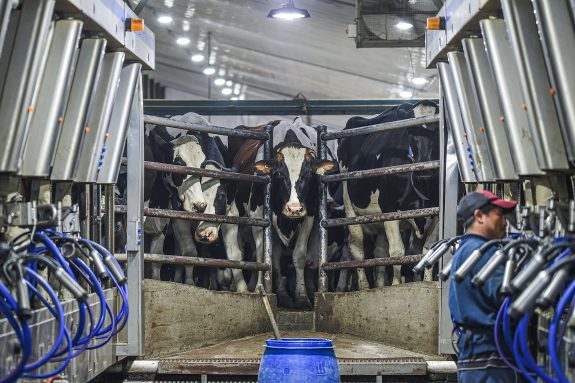The dairy industry has released a new code of practice for the treatment of cows and calves on dairy farms. Shockingly, the new guidance still allows heartbreaking cruelty—including separating baby cows from their mothers immediately after birth, tying cows up all day long inside filthy stalls, and keeping cows indoors for their entire lives.
Canada has some of the worst animal protection laws in the western world. Unlike other modern countries, Canada lacks provincial and federal laws that regulate the treatment of animals on farms, nor are there regular government inspections to check conditions on farms. Instead, an industry-dominated body called the National Farm Animal Care Council (NFACC) creates voluntary “codes of practice” for the use of animals on farms. The NFACC codes are no substitute for binding laws and transparent enforcement by government agencies.
Animal Justice supporters took part in an NFACC survey while the dairy code was being developed to encourage the industry to end some of the worst abuses—like separating mothers and babies, limiting cow movement by tying them to stalls, and denying cows access to the outdoors. Yet the new dairy code still allows all of these cruel practices, and many others. Dairy farmers are clearly most concerned about increasing profits, and are willing to disregard cows and calves in the process.
Here are some of the most cruel and disappointing practices allowed in the new dairy code.
1. Cow-Calf Separation
Cows must give birth to produce milk, and are artificially inseminated by the farmer to become pregnant. The babies are typically taken away from their mothers as soon as they are born so the milk meant for the calves can be sold for profit.
It’s well known that this separation causes immense distress to both the mother and the calf. Gut-wrenching undercover footage released in 2021 by Animal Justice from Cedar Valley, an organic dairy farm in British Columbia, shows newborn calves taken from their mothers and thrown into wheelbarrows, while the mother cows cry out and desperately chase after their babies.
The scientific committee working on the code acknowledged cow-calf separation as the top priority animal welfare issue. Yet the new code is silent on separation—calves can still be taken away from their mothers immediately after birth.
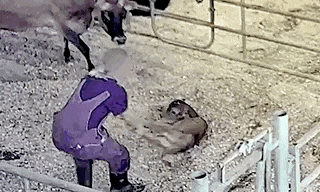
Video from Animal Justice’s exposé at Cedar Valley, an organic dairy farm in British Columbia.
2. Calves Can Be Tied Up & Kept Alone in Tiny Hutches
Male calves are useless to the dairy industry, so they are typically shot or sold for veal after they are stolen away from their mothers. But the female calves are often kept and raised to become dairy cows themselves.
Although tethering these calves is illegal in many other countries, the new dairy code says calves can be tied to tiny hutches, so long as the hutches are outdoors and they have access to some outdoor space. The code appears to recognize that the public is appalled by tethering—it encourages farmers to abandon tethering “to align with the long-term social sustainability of the industry, research on consumer/public viewpoints…”. Yet the code falls short of requiring an end to tethering.
Calves can also be kept all alone for the time being. By 2031, the code says calves should be kept in pairs or groups after they reach four weeks of age. This is cold comfort for calves kept in isolation, and for vulnerable baby calves who are less than four weeks old, and are doomed to live alone.
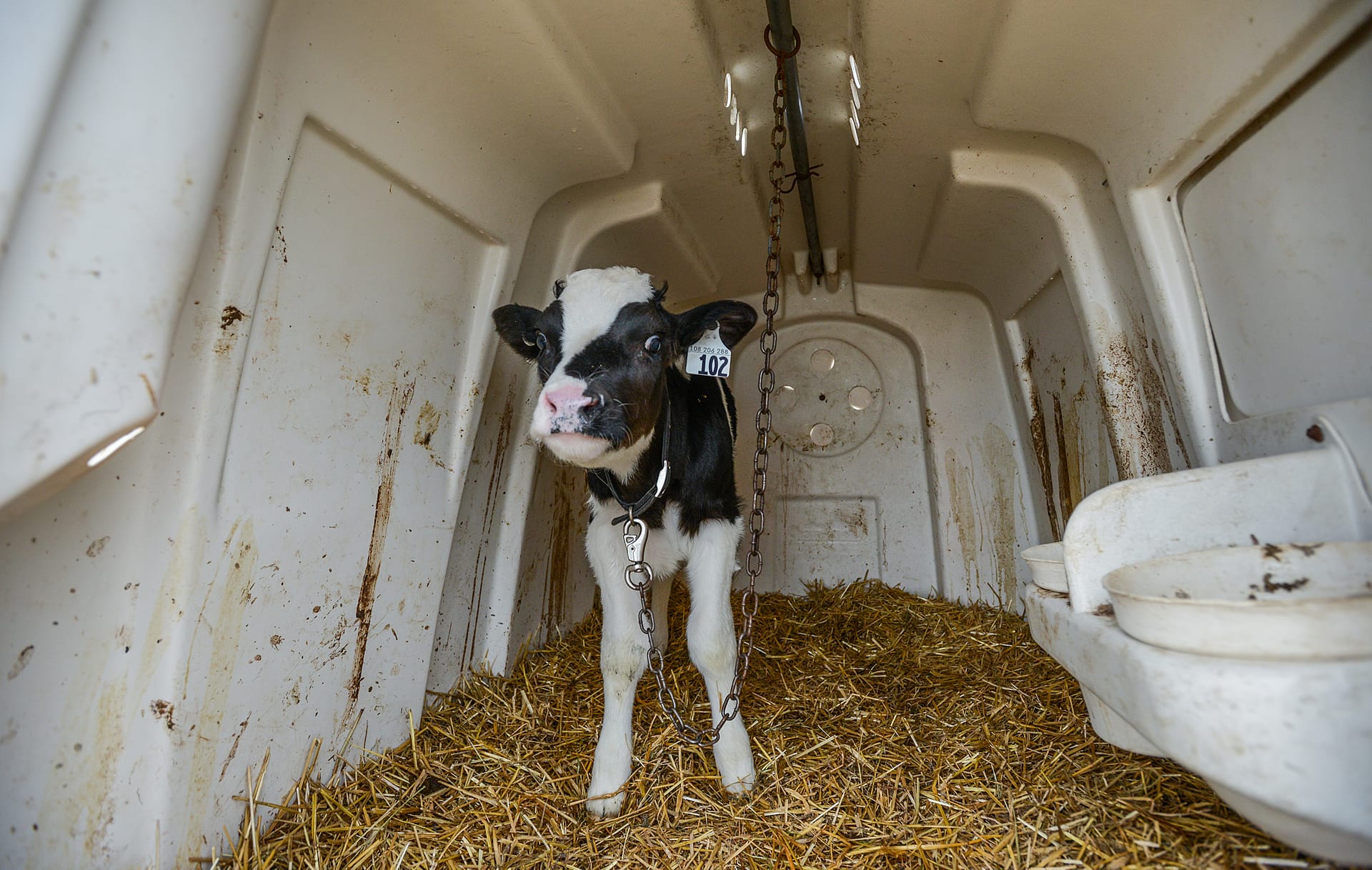
Photo: Jo-Anne McArthur | We Animals Media
3. Cows Can Still Be Tied in Stalls, Denied Outdoor Access
The new dairy code ignored public calls for an immediate end to tethering mother cows in stalls. A shocking 73% of cows are tethered inside their stalls when not being milked, according to the scientific committee, and this loss of movement is associated with higher rates of injuries to their hocks, knees, and neck.
As of 2027, the code says that a cow can’t be tethered for her entire “production cycle” (i.e., from one forcible impregnation and birth to the next) and should have “sufficient regular opportunity for freedom of movement”. But this vague language could still allow farmers to keep cows tethered for nearly the entire day. There’s also no requirement that tethers be of any particular length—merely a recommendation that they be at least one metre long.
The new dairy code also lets farmers keep cows inside barns their entire lives—no outdoor access is required. This is troubling, considering lack of access to the outdoors was “identified as a welfare concern” by the NFACC scientific committee, and cows have higher rates of injuries and illness when they can’t go outside. Instead, the code merely recommends (but does not require) that cows get around 50 hours outdoors per month, if the weather permits.
The code doesn’t set out any minimum or maximum temperature requirements to make sure cows are comfortable inside barns, nor does it include ventilation standards. There’s also no requirement for farmers to remove manure frequently, or clean the barns on any set schedule.
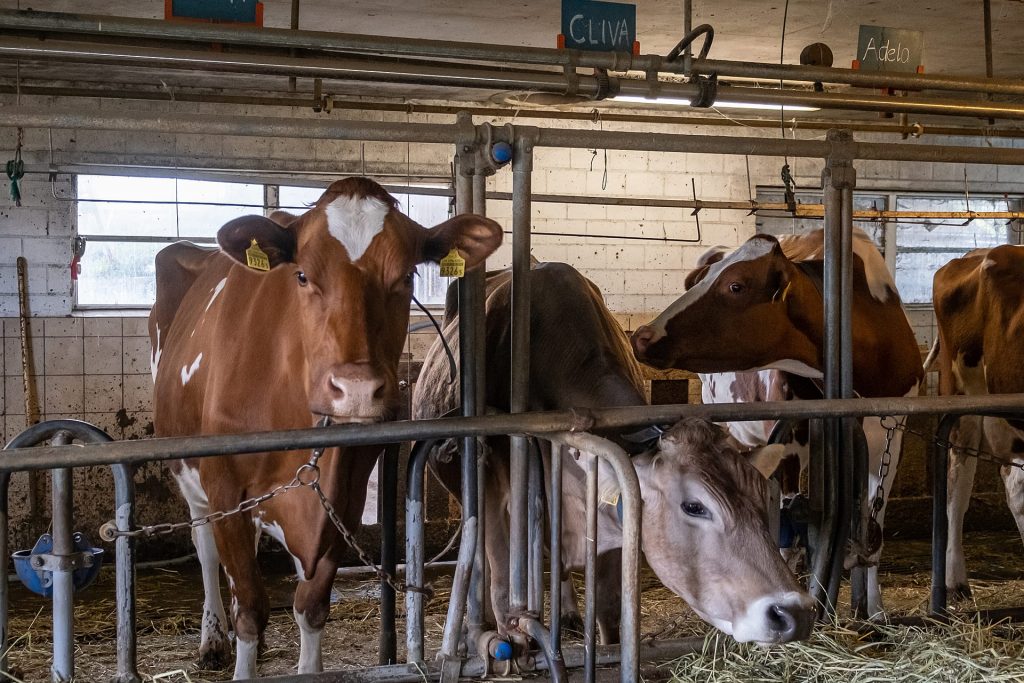
Photo: Sabina Diethelm | We Animals Media
4. Cows Can Be Shocked With Electricity
The code allows farmers to use electric “trainers” in stalls—an electrically-charged wire that shocks cows with up to 2500 volts to encourage them to urinate and defecate in the back of their stall. Even though these cruel devices are associated with increased injuries, they can be used to “train or retrain” cows.
5. No Emergency Plan Required, Despite Increase in Extreme Weather Disasters
Canadians watched with horror as cows drowned when British Columbia was hit with extreme rainfall in the fall of 2021. Despite this catastrophe, the new dairy code doesn’t require farmers to develop emergency protocols, design barns with emergencies in mind, or even have an evacuation plan for the animals.
With extreme weather events on the rise due to climate change, this is a serious problem.
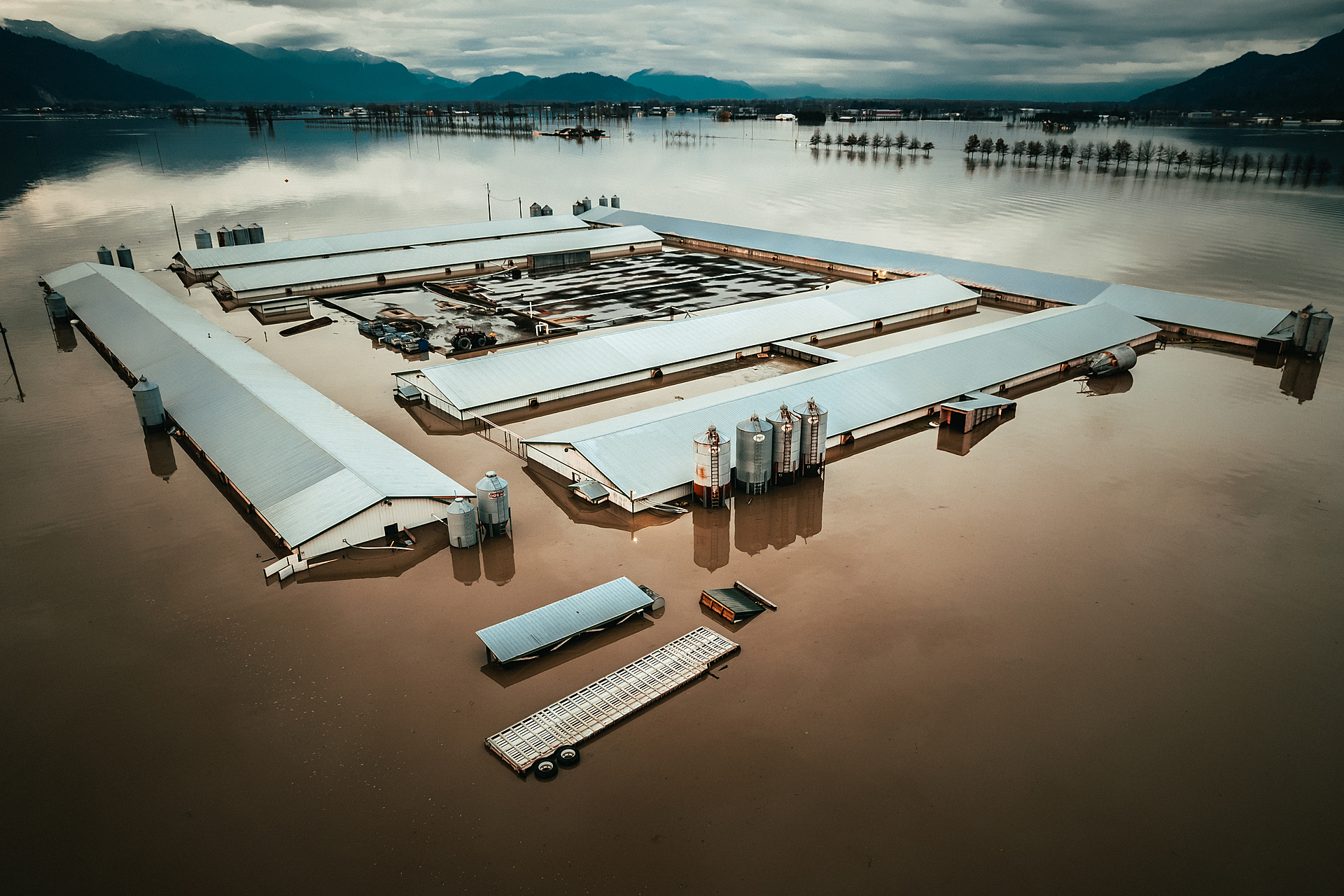
Photo: Nick Schafer Media | We Animals Media
6. No Protection for Pregnant & End-Of-Life Cows Sent to Slaughter
The constant, years-long cycle of impregnation, birth, and milking takes a toll on cows’ bodies, and can cause poor health, painful conditions like mastitis, and declining milk production. If she is sick or less productive, a cow is typically sent to slaughter to be killed for hamburger meat.
These end-of-life cows are often transported to slaughter with troubling illnesses and injuries. They endure long journeys, typically stopping first at an auction, and then sent across the border to be killed in the United States. This gruelling trip can take days at a time, and cows often suffer from painful injuries and lack of milking along the way.
The new dairy code has no requirements to ensure less suffering for cows who are being sent to slaughter.
It’s also common for pregnant cows to be sent to slaughter. Canadian animal advocates regularly document slaughterhouses tossing advanced calf fetuses into dumpsters.
7. Other Ways Cows Will Suffer
This is just a snapshot of some of the worst abuses the dairy industry approves of through its new code. Other problems include:
- Electric prods are allowed—they can still be used in “extreme” situations, or to shock a downed cow to see if she can move.
- Dehorning and disbudding cows is still allowed, instead of requiring only breeds that are genetically hornless. This is despite an acknowledgment that “all methods of disbudding and dehorning are painful at any age.”
- Calves aren’t protected during transport—babies can be trucked immediately after birth, at a very vulnerable time.
- Relying on outcome-based measures, instead of specific, clear requirements. This means that instead of laying out how animals should be treated in specific terms (i.e., temperatures should be kept between 15-25 degrees Celsius for young calves), the code simply states facilities must minimize the risk of heat and cold stress. Without specific requirements, farmers are given far too much leeway to make decisions that maximize profit at the expense of cows and calves.
Overall, Animal Justice gives the new dairy code a failing grade.
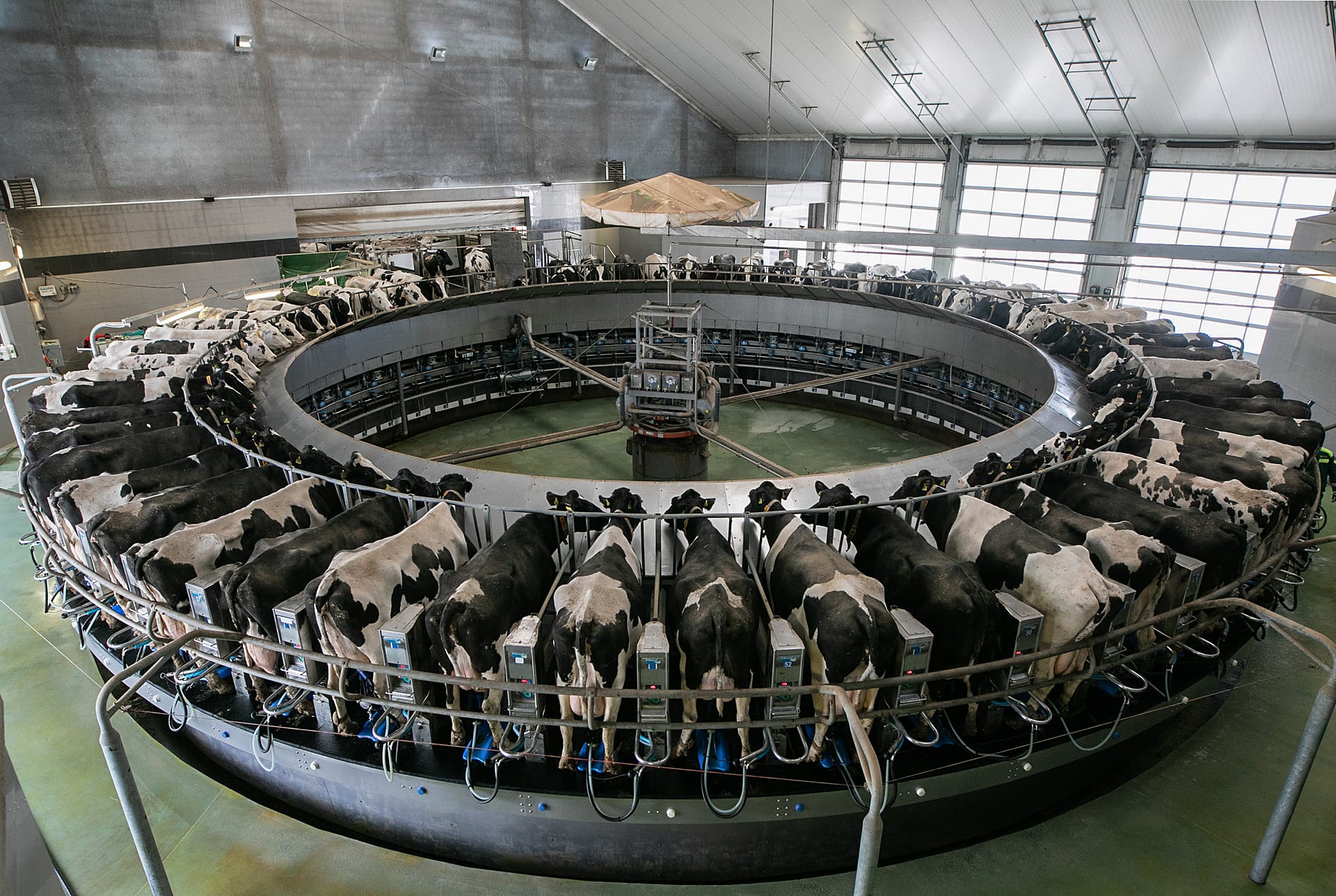
Photo: Andrew Skowron | We Animals Media
What Is the Legal Effect of the New Dairy Code?
The dairy code isn’t a law—it’s a voluntary standard produced largely by the industry itself. There are no federal or provincial regulations for the welfare of cows used for dairy. Instead, the dairy industry does its own inspections of farms through its proAction program. If the industry finds violations of code requirements, it can take remedial action—including revoking the ability of a farm to sell its milk through the supply-managed dairy pooling system.
While this might sound comforting, it’s not. The dairy industry doesn’t release information publicly about how many inspections it does, which farms it has inspected, how many farms are out of compliance with its own standards, and what, if any, action it has taken in response.
Based on government documents in British Columbia, we do know that over 25 percent of farms failed to comply with the dairy code, in inspections done by the industry through the BC Milk Marketing Board. The reports showed overcrowding, lame or soiled cattle, tails accidentally torn off by machinery, branding and dehorning of calves without pain medication, and cows lying on concrete without proper bedding.
This poor compliance is not surprising, considering the scientific committee for the new code also acknowledged that “less than half of the cows on tie-stall farms were housed in stalls that met the current recommendations” set out by the existing code of practice.
We also know that every time animal advocates go undercover to investigate a dairy farm, shocking abuse is revealed. For instance, Animal Justice’s exposé of Cedar Valley in 2021 showed workers hitting cows with canes, wrenches, and pitchforks; spraying hoses in their faces; and cows who were limping and appeared emaciated. A 2014 investigation at Chilliwack Cattle Sales resulted in convictions and massive fines, after footage showed workers beating cows with whips and canes; and hoisting them on a forklift with chains.
Help Cows: Call for Governments to Pass Laws Protecting Them
Ultimately, the dairy industry should not be left to make up its own rules, and self-police. Governments should pass laws to protect these animals from some of the worst abuses.
Take action today! Demand real laws and enforcement for farms in Canada.
Banner: Jo-Anne McArthur | We Animals Media

